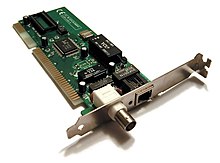
Back بطاقة الشبكة Arabic Мрежова карта Bulgarian Kartenn rouedad Breton Mrežna kartica BS Targeta de xarxa Catalan Síťová karta Czech Netkort Danish Netzwerkkarte German Κάρτα δικτύου Greek Retkarto Esperanto
 | |
| Connects to | Motherboard via one of:
Network via one of: |
|---|---|
| Speeds | Full-duplex or half-duplex:
Full-duplex:[1][2]
|
| Common manufacturers | Intel Realtek Broadcom (includes former Avago, Emulex) Marvell Technology Group Cavium (formerly QLogic) Mellanox Chelsio |
A network interface controller (NIC, also known as a network interface card,[3] network adapter, LAN adapter and physical network interface[4]) is a computer hardware component that connects a computer to a computer network.[5]
Early network interface controllers were commonly implemented on expansion cards that plugged into a computer bus. The low cost and ubiquity of the Ethernet standard means that most newer computers have a network interface built into the motherboard, or is contained into a USB-connected dongle.
Modern network interface controllers offer advanced features such as interrupt and DMA interfaces to the host processors, support for multiple receive and transmit queues, partitioning into multiple logical interfaces, and on-controller network traffic processing such as the TCP offload engine.
- ^ "Port speed and duplex mode configuration". docs.ruckuswireless.com. Retrieved 2020-09-25.
- ^ Admin, Arista (2020-04-23). "Section 11.2: Ethernet Standards - Arista". Arista Networks. Retrieved 2020-09-28.
- ^ Cite error: The named reference
Dellwas invoked but never defined (see the help page). - ^ "Physical Network Interface". Microsoft. January 7, 2009.
- ^ Posey, Brien M. (2006). "Networking Basics: Part 1 - Networking Hardware". Windowsnetworking.com. TechGenix Ltd. Retrieved 2012-06-09.